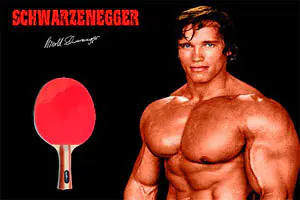Playing table tennis can relieve muscle tension after strength training. Not everyone has heard of this method, so I decided to share the information...
Did you know that the famous Champion Arnold Schwarzenegger loved to play table tennis in the gym after work? In the photo: six-time Mr. Olympia great Arnie and his signature racket.
Once upon a time, quite by chance, I met an acquaintance who, after strength training, was rushing to the table tennis hall. We talked to him, and he said that he regularly began to play ping pong to relieve stiffness and tension in his muscles. I didn’t really believe in the effectiveness of this technique, but I still decided to try it myself and the next day I went to a sports store and bought a racket. After the usual workout in the gym, I, a little tired, went to the table tennis room. I was surprised by its size, number of people and tables. I found an opponent - a beginner like me. Warm up for about 20 minutes. Then counting game. And although I lost all the games, that’s not important... Now about my impressions. It’s strange, but it was precisely this alternation of load that had a positive effect on the condition of the muscles. I liked the emotionality of the game.
Several years have passed, but I still continue to play table tennis. If before I walked only to relieve muscle tension, now I just want to play. During this time, I became more experienced and understand rackets and all the nuances of the game. I share my experience and hope that it will help you when choosing a racket.
A table tennis racket consists of a base, a sponge and a top sheet of rubber. The bases are made of wood. According to the rules of the International Table Tennis Federation, the base must contain at least 85% wood. The sponge and top sheet together form a table tennis rubber. The sponge gives elasticity to the rubber and speed in play. The hardness of the sponge is measured in degrees and varies from 30 to 50. The thickness of the sponge can also vary from 0.3 to 2.2 mm. The thinner the sponge, the weaker the ball's rebound and the lower its flight speed. Thin sponge is used in rubbers for defensive play or for beginner tennis players. In the new generation of rubbers, the sponge is in a tense state and has a built-in plywood effect, which gives a lot of advantages in attacking play. Such overlays are also called tensor overlays.
The design of some blades may contain carbon material, which increases the hardness of the racket and gives additional speed to the ball, increasing the spot of the best rebound. The carbon fiber layers are black and visible on the end of the racket. Carbon rackets are generally faster than regular rackets and are better suited for attacking play.
Post Views: 109


